Angiotensin Receptor Neprilysin Inhibitor Attenuates Myocardial Remodeling and Improves Infarct Perfusion in Experimental Heart Failure
- PMID: 30962467
- PMCID: PMC6453892
- DOI: 10.1038/s41598-019-42113-0
Angiotensin Receptor Neprilysin Inhibitor Attenuates Myocardial Remodeling and Improves Infarct Perfusion in Experimental Heart Failure
Abstract
Angiotensin receptor blocker-neprilysin inhibitor (ARNi) therapy improves the prognosis of heart failure patients. However, the mechanisms remain unclear. This study investigated the biological effects of ARNi with neprilysin inhibitor sacubitril and angiotensin receptor blocker valsartan on myocardial remodeling and cardiac perfusion in experimental heart failure (HF) after myocardial infarction (MI). Male Lewis rats (10-weeks old) with confirmed HF were randomized one-week post-MI to treatment with vehicle (water), sacubitril/valsartan or valsartan, as comparator group, for either 1 or 5 weeks. Sacubitril/valsartan for 1-week limited LV contractile dysfunction vs. vehicle and both sacubitril/valsartan and valsartan attenuated progressive LV dilation after 1 and 5 weeks treatment. After 5 weeks, both sacubitril/valsartan and valsartan reduced CTGF expression in the remote myocardium, although only sacubitril/valsartan prevented interstitial fibrosis. In the border zone, sacubitril/valsartan and valsartan reduced hypertrophic markers, but only sacubitril/valsartan reduced cardiomyocyte size and increased VEGFA expression. In the infarct, sacubitril/valsartan induced an early uptake of 99mTc-NC100692 (a radiotracer of angiogenesis) and improved perfusion, as determined by 201Tl microSPECT/CT imaging. In conclusion, ARNi improved global LV function, limited remodeling in the remote and border zones, and increased perfusion to the infarct. Sacubitril/valsartan had more consistent effects than valsartan on LV remodeling in experimental HF.
Conflict of interest statement
The authors declare no competing interests.
Figures

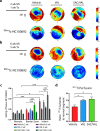
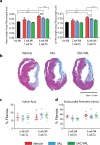

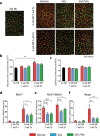
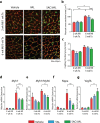
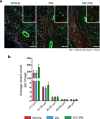
Similar articles
-
Angiotensin receptor neprilysin inhibitor LCZ696 attenuates cardiac remodeling and dysfunction after myocardial infarction by reducing cardiac fibrosis and hypertrophy.Circ Heart Fail. 2015 Jan;8(1):71-8. doi: 10.1161/CIRCHEARTFAILURE.114.001785. Epub 2014 Oct 31. Circ Heart Fail. 2015. PMID: 25362207
-
Combined Angiotensin Receptor Antagonism and Neprilysin Inhibition.Circulation. 2016 Mar 15;133(11):1115-24. doi: 10.1161/CIRCULATIONAHA.115.018622. Circulation. 2016. PMID: 26976916 Free PMC article. Review.
-
The impact of Sacubitril/Valsartan on cardiac fibrosis early after myocardial infarction in hypertensive rats.J Hypertens. 2022 Sep 1;40(9):1822-1830. doi: 10.1097/HJH.0000000000003230. Epub 2022 Jul 22. J Hypertens. 2022. PMID: 35943105
-
Effect of Neprilysin Inhibition for Ischemic Mitral Regurgitation after Myocardial Injury.Int J Mol Sci. 2021 Aug 10;22(16):8598. doi: 10.3390/ijms22168598. Int J Mol Sci. 2021. PMID: 34445301 Free PMC article.
-
Sacubitril/Valsartan (LCZ696) in Heart Failure.Handb Exp Pharmacol. 2017;243:133-165. doi: 10.1007/164_2016_77. Handb Exp Pharmacol. 2017. PMID: 28004291 Review.
Cited by
-
Strain-dependent stress relaxation behavior of healthy right ventricular free wall.Acta Biomater. 2022 Oct 15;152:290-299. doi: 10.1016/j.actbio.2022.08.043. Epub 2022 Aug 24. Acta Biomater. 2022. PMID: 36030049 Free PMC article.
-
Nuclear Molecular Imaging of Cardiac Remodeling after Myocardial Infarction.Pharmaceuticals (Basel). 2022 Jan 31;15(2):183. doi: 10.3390/ph15020183. Pharmaceuticals (Basel). 2022. PMID: 35215296 Free PMC article. Review.
-
Sacubitril/valsartan mitigates cardiac remodeling, systolic dysfunction, and preserves mitochondrial quality in a rat model of mitral regurgitation.Sci Rep. 2023 Jul 16;13(1):11472. doi: 10.1038/s41598-023-38694-6. Sci Rep. 2023. PMID: 37455281 Free PMC article.
-
Sacubitril/valsartan versus angiotensin inhibitors and arrhythmia endpoints in heart failure with reduced ejection fraction.Heart Rhythm O2. 2021 Dec 17;2(6Part B):724-732. doi: 10.1016/j.hroo.2021.09.009. eCollection 2021 Dec. Heart Rhythm O2. 2021. PMID: 34988523 Free PMC article.
-
ARNi: A Novel Approach to Counteract Cardiovascular Diseases.Int J Mol Sci. 2019 Apr 28;20(9):2092. doi: 10.3390/ijms20092092. Int J Mol Sci. 2019. PMID: 31035359 Free PMC article. Review.
References
-
- Yancy CW, et al. ACC/AHA/HFSA Focused Update on New Pharmacological Therapy for Heart Failure: An Update of the 2013 ACCF/AHA Guideline for the Management of Heart Failure: A Report of the American College of Cardiology/American Heart Association Task Force on Clinical Practice Guidelines and the Heart Failure Society of America. J Am Coll Cardiol. 2016;68:1476–1488. doi: 10.1016/j.jacc.2016.05.011. - DOI - PubMed
Publication types
MeSH terms
Substances
Grants and funding
LinkOut - more resources
Full Text Sources
Medical
Research Materials
Miscellaneous

